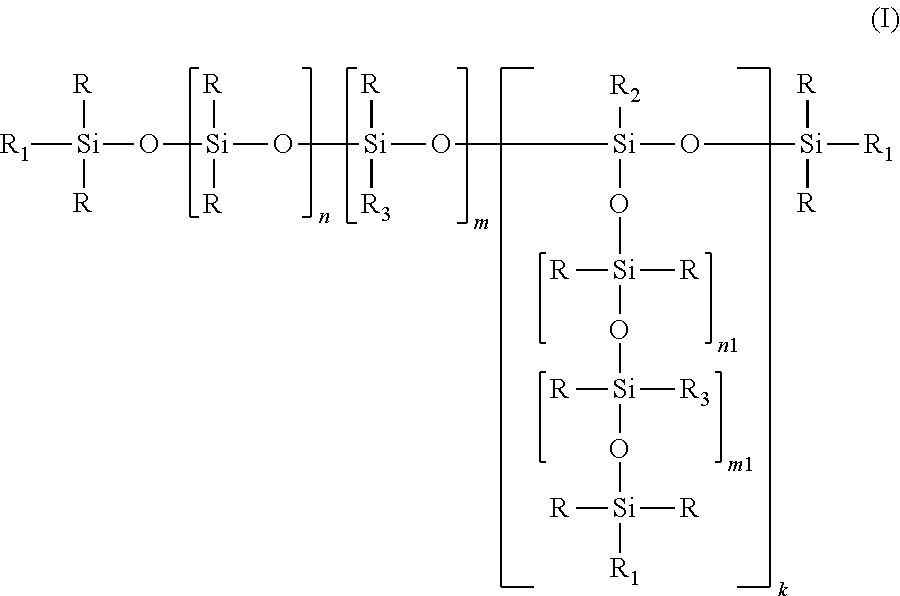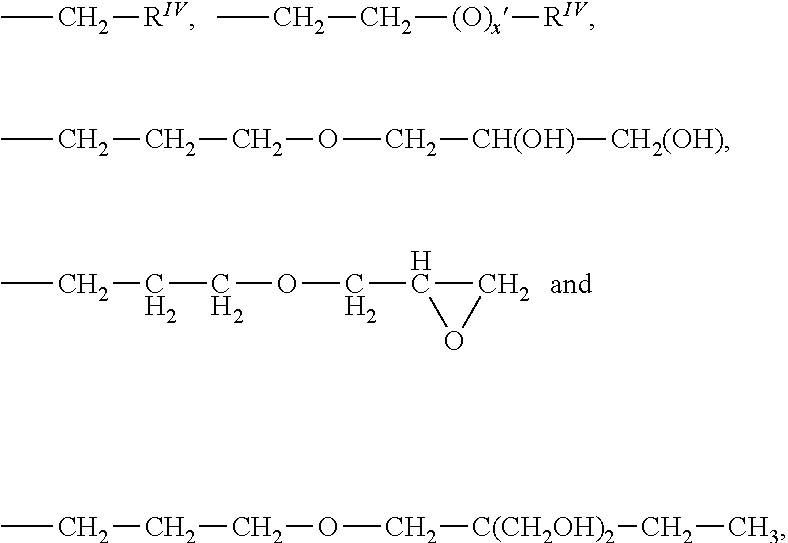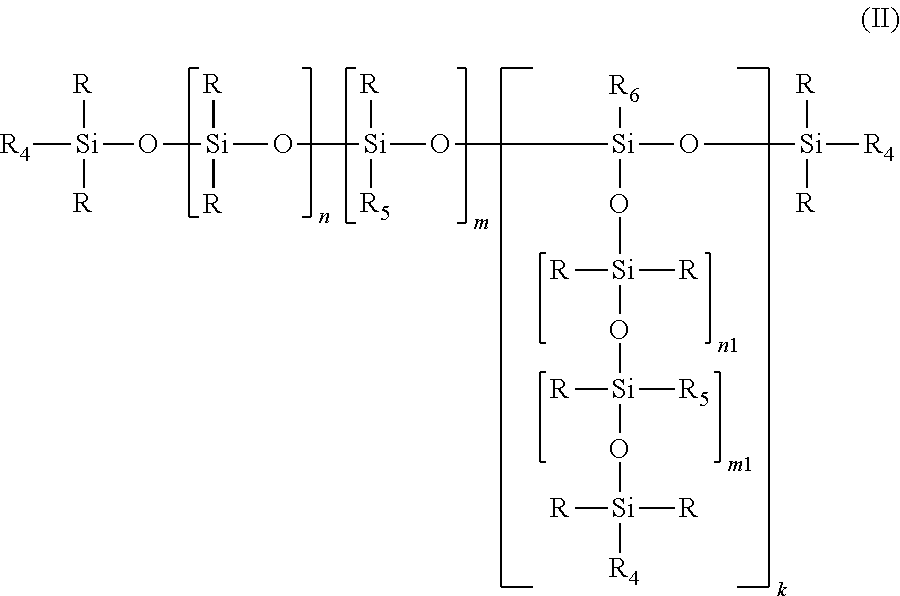Alkyl carbonate endcapped polyether siloxanes and preparation thereof
a polyether and polyether technology, applied in the field of polysiloxanepolyether copolymers, can solve the problems of limited prediction of the effect of polysiloxane-polyoxyalkylene copolymer in foam stabilization, affecting the stability of the stabilizer, and limiting the shelf life of the stabilizer, so as to achieve the effect of saving energy and raw materials
- Summary
- Abstract
- Description
- Claims
- Application Information
AI Technical Summary
Benefits of technology
Problems solved by technology
Method used
Image
Examples
example 1
Not According to the Invention
[0072]In a 500-ml 4-neck round-bottomed flask equipped with KPG stirrer, thermometer, gas inlet tube and reflux condenser, a mixture of
82.1 g of a polyether having the average formula
CH2═CH—CH2O—(C2H4O)4(C3H6O)20—CH3 with
15.8 g of a polyether having the average formula
CH2═CH—CH2O—(C2H4O)13(C3H6O)13—CH3 and
39.9 g of a polyether having the average formula
CH2═CH—CH2O—(C2H4O)36 (C3H6O)37—CH3 and also
119.3 g of a polyether having the average formula
CH2═CH—CH2O—(C2H4O)36 (C3H6O)37—H
[0073]and 60 g of a poly(methylhydrogen)polydimethylsiloxane copolymer having an average molecular weight of 5000 g / mol and an SiH content of 1.30 mmol / g under vigorous agitation and inert gas blanketing was heated to 70° C. and then admixed with 5 ppm of Pt (based on the total batch) in the form of the so-called WK catalyst described in EP 1 520 870. The sodium butoxide-induced decomposition of a reaction mixture aliquot drawn after 2 hours and weighed into a gas decomposition app...
example 2
Not According to the Invention
[0074]In a 500-ml 4-neck round-bottomed flask equipped with KPG stirrer, thermometer, gas inlet tube and reflux condenser, a mixture of
85.7 g of a polyether having the average formula
CH2═CH—CH2O—(C2H4O)4(C3H6O)20—H with
15.4 g of a polyether having the average formula
CH2═CH—CH2O—(C2H4O)13(C3H6O)13—H and
164.5 g of a polyether having the average formula
CH2═CH—CH2O—(C2H4O)36(C3H6O)37—H
[0075]and 60 g of a poly(methylhydrogen)polydimethylsiloxane copolymer having an average molecular weight of 5078 g / mol and an SiH content of 1.28 mmol / g under vigorous agitation and inert gas blanketing was heated to 70° C. and then admixed with 5 ppm of Pt (based on the total batch) in the form of the so-called WK catalyst described in EP 1 520 870. The sodium butoxide-induced decomposition of a reaction mixture aliquot drawn after 2 hours and weighed into a gas decomposition apparatus did not display any hydrogen release whatsoever and thus evidenced complete SiH conversion...
example 3
According to the Invention
Ethyl Carbonate Endcapping of Polyether Siloxane Obtained in Example 2
[0076]200 g of the hydroxyl-functional polyether siloxane obtained in Example 2 were together admixed with 30 g (0.254 mol) of diethyl carbonate and 4.6 g of potassium carbonate (2 mass percent based on total batch) and the reaction mixture was heated in a rotary evaporator at 140° C. for 3 hours. Volatiles were distillatively removed by applying an auxiliary vacuum (about 1 mbar oil pump vacuum). Following removal of solids by filtration in a pressure filter press through a Seitz K 300 filter disc, a clear, slightly yellowish liquid product was isolated with an OH number of 9.7 mg of KOH / g of substance. This OH number corresponded to a degree of ethyl carbonate endcapping (based on all OH groups) of 46 mol %.
PUM
| Property | Measurement | Unit |
|---|---|---|
| temperature | aaaaa | aaaaa |
| pressure | aaaaa | aaaaa |
| temperature | aaaaa | aaaaa |
Abstract
Description
Claims
Application Information
 Login to View More
Login to View More - R&D
- Intellectual Property
- Life Sciences
- Materials
- Tech Scout
- Unparalleled Data Quality
- Higher Quality Content
- 60% Fewer Hallucinations
Browse by: Latest US Patents, China's latest patents, Technical Efficacy Thesaurus, Application Domain, Technology Topic, Popular Technical Reports.
© 2025 PatSnap. All rights reserved.Legal|Privacy policy|Modern Slavery Act Transparency Statement|Sitemap|About US| Contact US: help@patsnap.com



